NCEA Level 3 Biology - Speciation
1/81
There's no tags or description
Looks like no tags are added yet.
Name | Mastery | Learn | Test | Matching | Spaced |
|---|
No study sessions yet.
82 Terms
Evolution
The change in allele frequencies in a population over time
Species
a group of individuals that interbreed/ potentially interbreed and produce fertile offspring
Population
A group of individuals that belong to the same species and live in the same area at the same time
Deme
a subset of a population that has limited gene flow with members of the main population.
Cline
a pattern of gradual variation between individuals where there is a continuous increase or decrease in a phenotypic characteristics between adjacent population
Gene flow
When individuals migrate (move) between populations and interbreed, they introduce their alleles into other populations.
Genetic drift
The random change in allele frequencies of a population due to chance events. Genetic drift occurs in all populations, but it has a much greater effect on the gene pool when the population is small as the result of some individuals not breeding and therefore not passing on their alleles.
Bottleneck effect
a process of genetic drift in which a population is reduced to a small number of survivors resulting in a new population with an allele frequency not representative of the initial population.
Founder effect
a process of genetic drift in which a small number of individuals become isolated from their original population resulting in a new population with an allele frequency not representative of the initial population.
Natural selection
Process in which individuals that have phenotypes better suited to their environment tend to survive longer and therefore produce more offspring and pass on their favourable alleles. These alleles then become more common in the population.
Patterns of natural selection
- Stabilising natural selection
- Directional natural selection
- Disruptive natural selection
Stabilising natural selection
Evolutionary process of selection that favours the average phenotype and selects against both extremes.
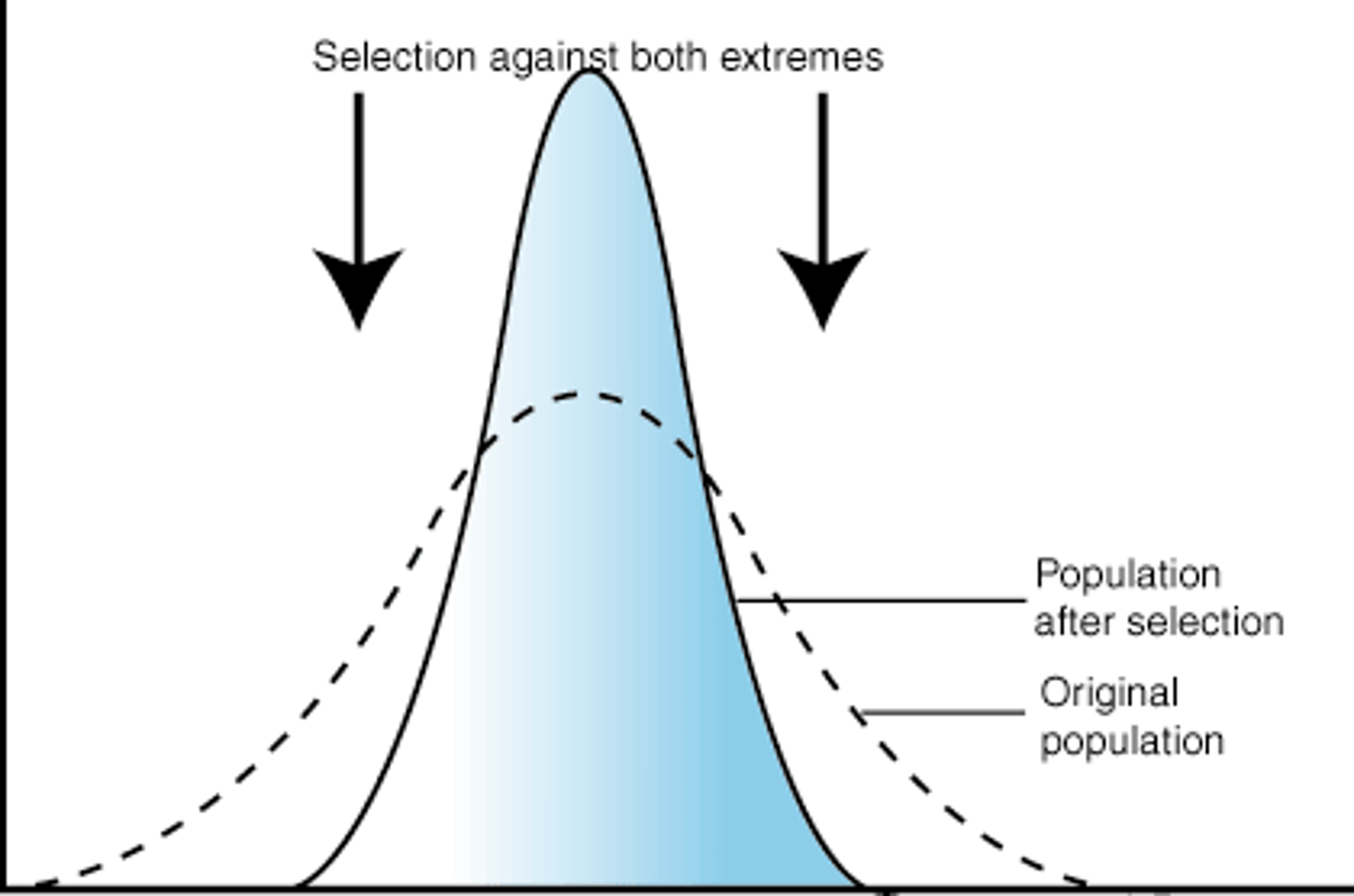
Directional natural selection
Evolutionary process of selection that favours one extreme phenotype over the others.
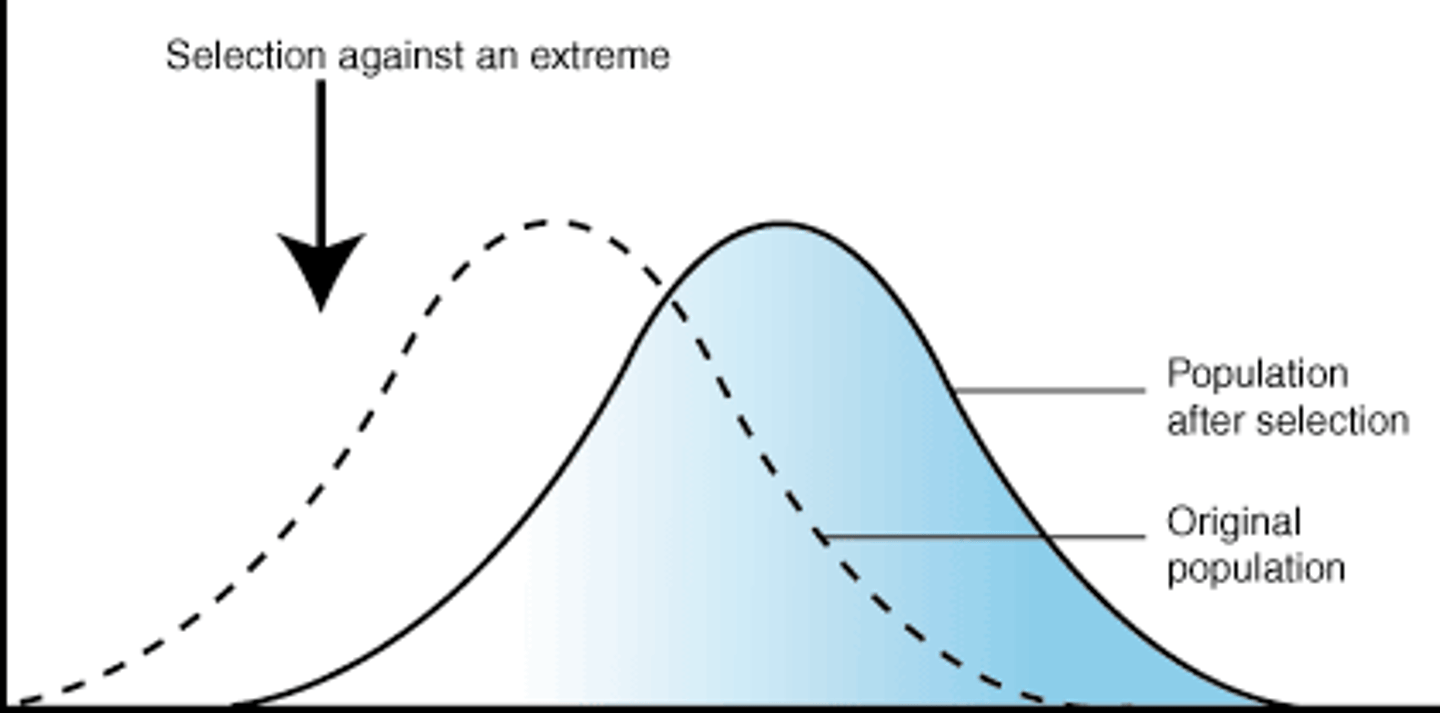
Disruptive natural selection
Evolutionary process of selection that favours both extreme phenotypes at the expense of the average and can even lead to the development of 2 or more different species from the one original species.
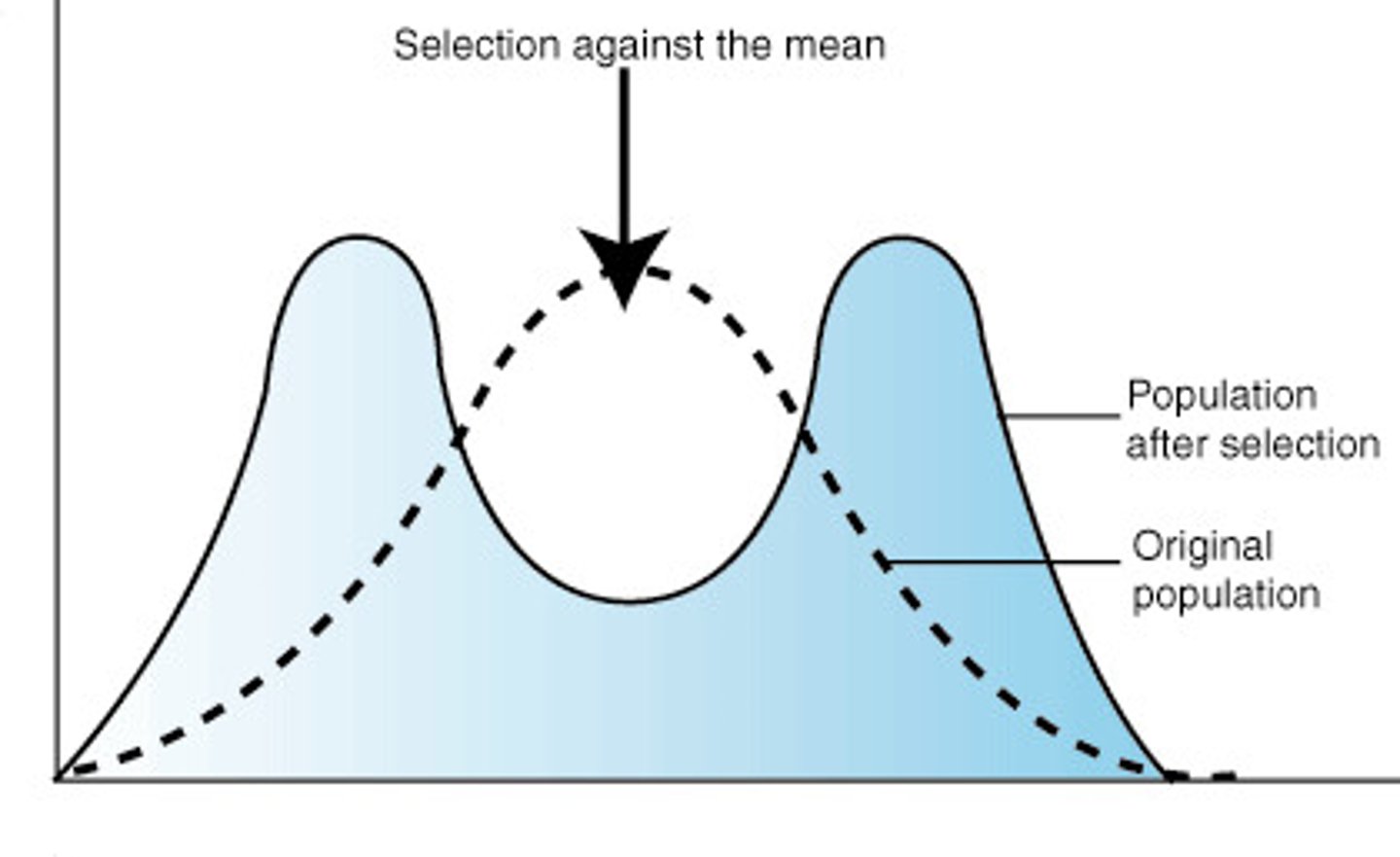
sexual selection
Natural selection arising through preference by one sex for certain characteristics in individuals of the other sex. - directional
Proteins and evolutionary relationships
Proteins are made specific amino acid sequences. The more similar their proteins (the more amino acids they have in common), the more closely related 2 organisms are. This is used for identifying between more distantly related species.
Beneficial Mutations
A mutation that affects the organism in some way as to increase its chances of reproductive success, and therefore the chance of the mutation in question being passed along.
Gene mutations
A permanent change in the base sequence of DNA which can result in a new allele being formed which can lead to a new phenotype
Polyploidy
condition in which an organism has more than 2 sets of chromosomes.
Autopolyploidy
Involves the formation of a polyploid from a single parental species and results from the failure of chromosomes to separate during cell division.
Somatic doubling (amphiploidy)
In mitosis 1 before the first cell splits, the DNA replicates, but cell does not split, causing a cell to now have an double number of chromosomes. Allows sterile polyploids to become fertile

Fertility in triploids
Triploids (produced by fertilisation between a diploid and a haploid gamete) are highly infertile, because of the very low probability that meiosis will produce cells with balanced chromosome sets.
Allopolyploidy
Results from hybridisation between species and chromosome doubling must occur for viable offspring to be produced by the hybrid.
Fertility in tetraploids
Tetraploids are usually fertile as they are able to form viable pairs of chromosomes during meiosis (each daughter nucleus can receive 2 chromosomes).
Speciation
The evolutionary process by which populations of the same species evolve and split into separate new species as a result of becoming reproductively isolated.
Reproductive isolating mechanism
Any factor that stops members of populations of the same species or members of different species from breeding together; it acts as a barrier to gene flow. RIMs may be:
- prezygotic: act before the egg is fertilised
- postzygotic: act after the egg is fertilised
Geographical isolation
Pre-zygotic RIM that results in physical barriers (e.g. rivers, mountain ranges, oceans) separating populations. If the populations come together again at a later stage, they are sufficiently different (as a result of different selection pressures in different environments, and/or possibly genetic drift) that they do not/are unable to breed.
Mechanical/structural isolation
Pre-zygotic RIM that results in differences between the structure of external reproductive organs (genitalia) that do not allow for transfer of sperm between the sexes.
Ecological isolation
Pre-zygotic RIM that results in differences in habitat within the same geographical area, so that the populations rarely come into contact with each other.
Temporal isolation
Pre-zygotic RIM that results in breeding behaviour resulting at different, non-overlapping times. There can be daily or seasonal differences in timing of mating or pollination.
Behavioural isolation
Pre-zygotic RIM that results in differences in behaviour, typically mating behaviour such as courtship or times/places of activity
Gametic incompatability
Type of pre-zygotic RIM that results from incompatibility of gametes.
Postzygotic isolating mechanisms
A reproductive isolating mechanism in which sperm may fertilise eggs of different species to form a hybrid but these are usually inviable or sterile
Allopatric speciation
Speciation that occurs when a population becomes divided into 2 or more populations by a geographical barrier, causing the populations to become geographically isolated and exposed to different selection pressures, and since there is no gene flow between them, the gene pools begin to diverge.
Sympatric speciation
Speciation where one species gives rise to 2 or more species without prior geographical separation. Usually due to niche or behavioural differentiation.
Biogeography
Study of past and present distribution of organisms
Rates of evolution
- Gradualism
- Punctuated equilibrium
Gradualism
A rate evolutionary change in which new species arise from the result of slight modifications (mutations and resulting phenotypic changes) over many generations, resulting from different, often constant, selection pressures. Transitional fossils found.
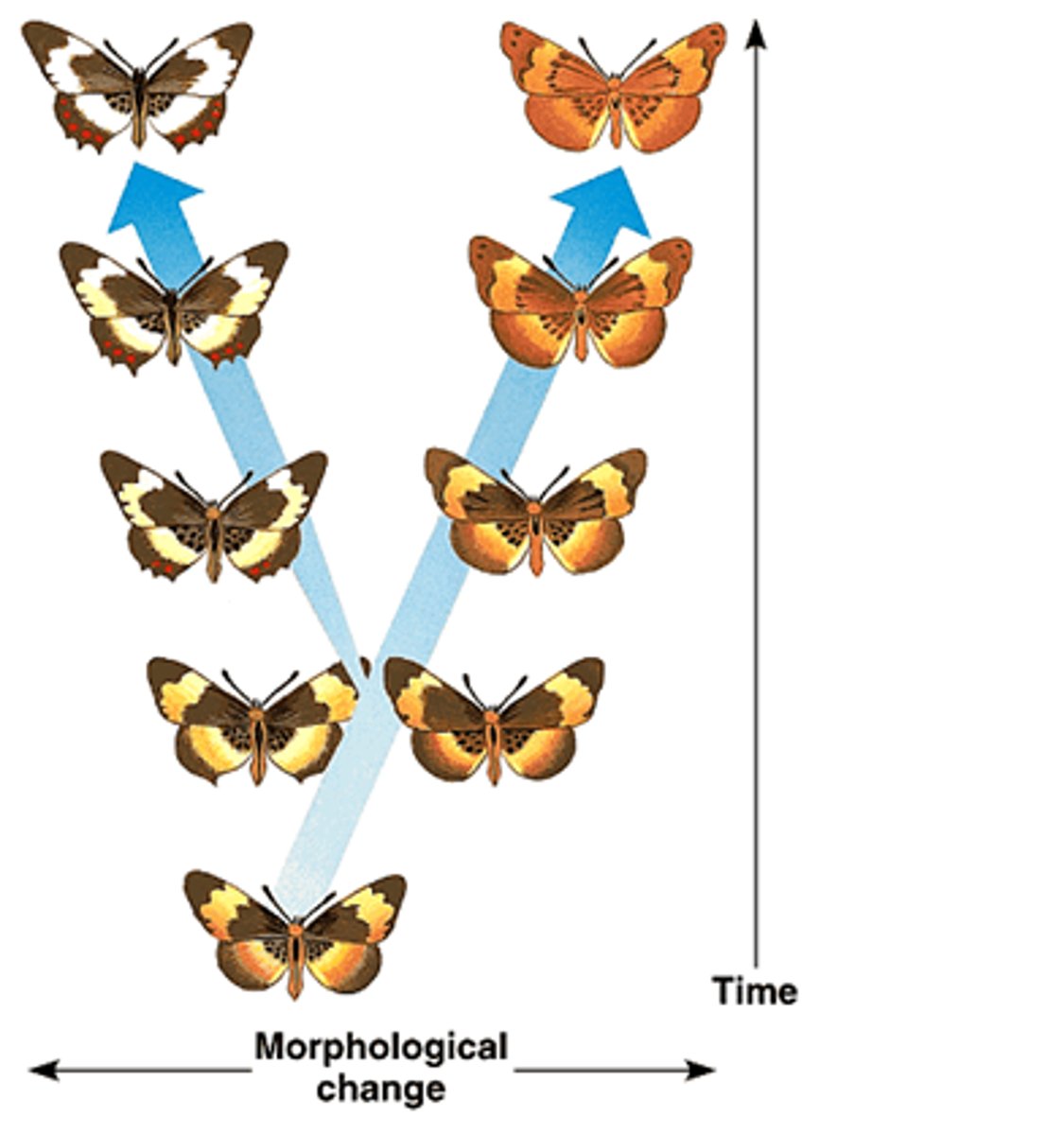
Punctuated equilibrium
A rate of evolutionary change in which there are long stable periods of stasis, interrupted by brief periods of more rapid change, resulting from diverse selection pressures selecting rapidly for a change in form
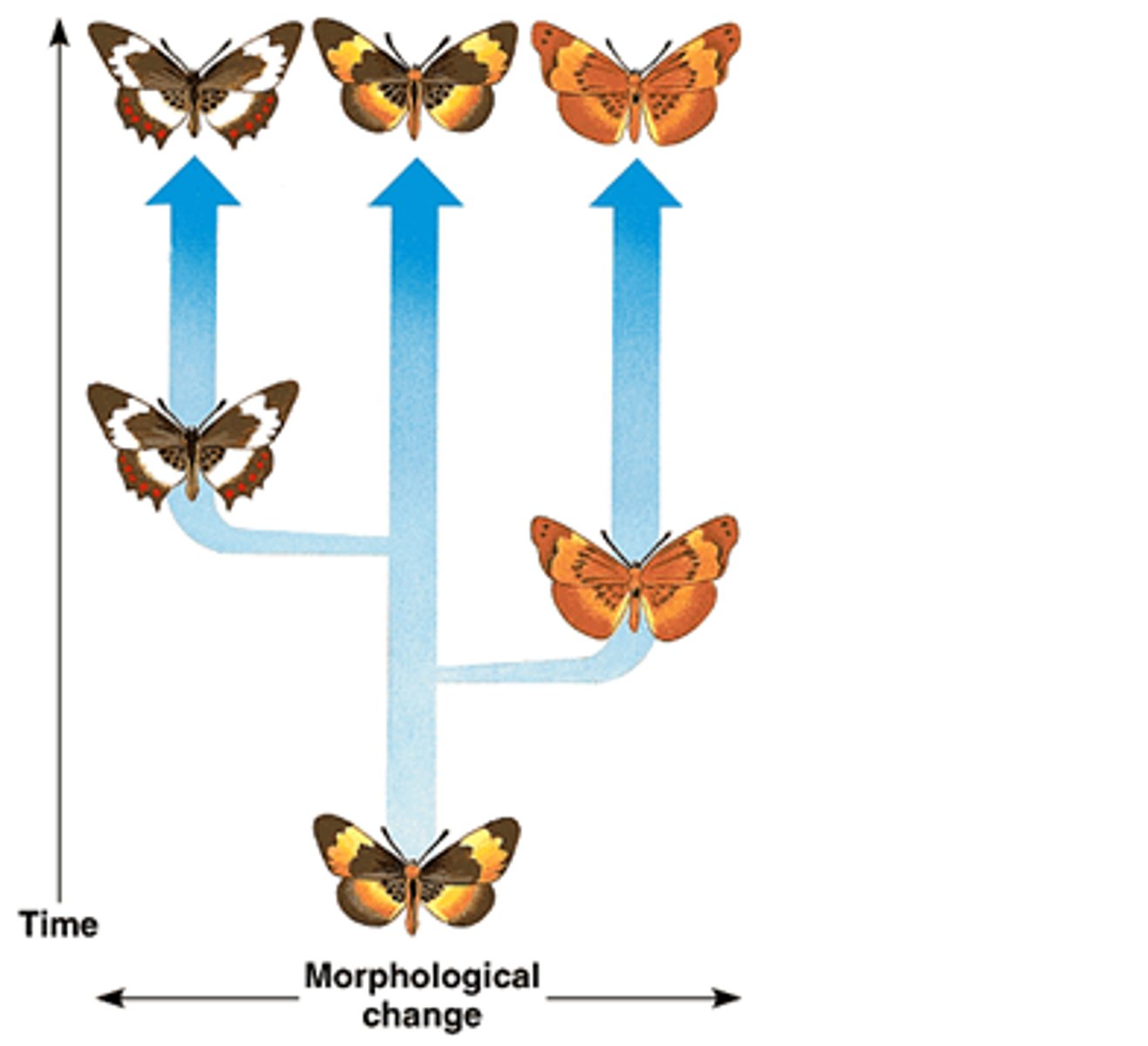
Patterns of evolution
- Divergent evolution
- Convergent evolution
- Co-evolution
- Adaptive radiation
-Parallel evolution
Divergent evolution
A pattern of evolution when two or more species result from a common ancestor.
mtDNA
Mitochondria contain DNA that does not undergo any recombination events - any changes in mtDNA are due to gene mutation and can therefore be used as a molecular "clock" as gene mutations occur at a steady, fairly rapid rate.
Homologous structures
Features similar in structure and origin but possibly different in function. The similarity in structure indicates common ancestry, while difference in function indicates adaptation to different selection pressures in different environments. It is an important source of evidence for divergence and adaptive radiation.
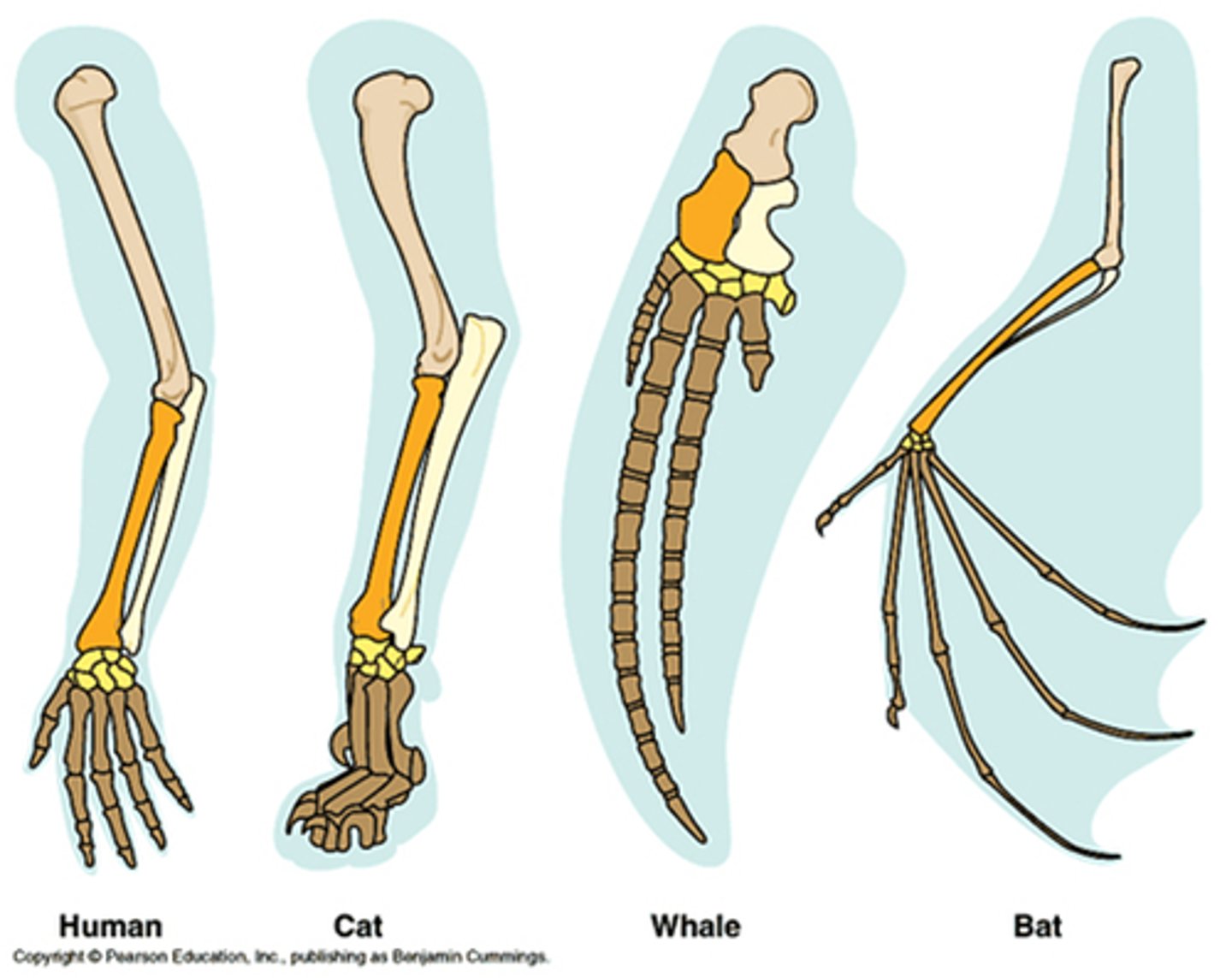
Convergent evolution
Pattern of evolution that occurs when two or more unrelated species evolve to resemble each other phenotypically as a result of being subject to similar selection pressures.
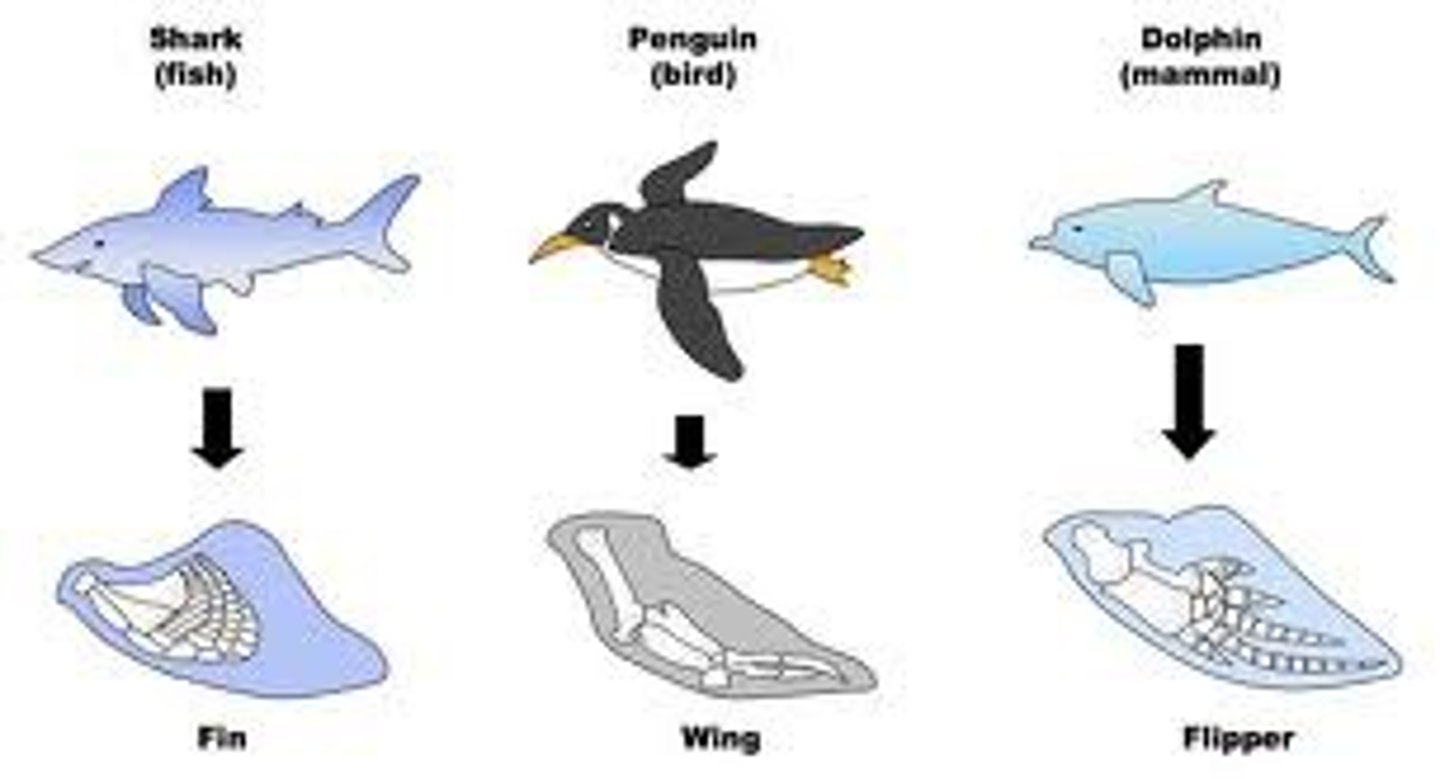
Co-evolution
A pattern of evolution in which a change in a feature of a species acts as a selection pressure for a change in the feature of another (unrelated species); both species have a strong ecological relationship with each other e.g. pollinators and flowering plants.
Clinal Variation
Gradient of variation caused by an environmental gradient. There are 2 different mechanisms by how this could occur:
- It could be due to environmental differences that affect the phenotype
- It could be due to genetic differences resulting from selection in different environmental conditions
Analogous structures
Structures with different evolutionary origins that appear very similar because they carry out the same or similar functions. Evidence for convergent evolution.
Causes of adaptive radiation
When members of an ancestral species move into new environments, this may involve out-competing and displacing other species, or habitats may become available through a catastrophic event (e.g. mass dinosaur extinctions left vacant niches for mammals to occupy). Populations are subject to new selection pressures, and new adaptations evolve. Can also result from the sudden relaxation of competition, which can arise in different ways:
- evolution of some new structure, physiology or behaviour enabling exploitation of a different aspect of a habitat
- geographical isolation from competitors or predators
-extinction of competitor species
Molecular biology and evolutionary relationships
Molecular biology can provide proof of evolutionary relationships as since DNA is common to all life forms, comparisons of the base sequence of the DNA of the genome of organisms can be used as an indicator of how closely related organisms are - the more DNA there is in common, the more closely related organisms are. This is good for identifying closely related organisms e.g. humans and chimps.
Niche
A niche is the role or function of an organism within its habitat, including how it obtains resources, interacts with other organisms, and contributes to the ecosystem.
Hox genes
A group of related genes that specify regions of the body plan of an embryo along the head-tail axis of the body
LUCA
Last universal Common Ancestor
yDNA
DNA found in the Y chromosome, which is passed from father to son with very little change
Polyploidy caused by…
Non-dysjunction
Euploidy
A type of ploidy mutation where a whole set of chromosomes fail to seperate causing the organism to have a ploidy mutation but their chromosome sets are in whole numbers (3n, 4n, 5n)
Aneuploidy
Individual has a different number of chromosomes than normal, caused by non-dysjunction of one chromosome 2n+1 or 2n-1
What happens when organism becomes extinct
it opens up a niche
Ring Species
a situation in which two populations which do not interbreed are living in the same region and connected by a geographic ring of populations that can interbreed
Parallel evolution
when similar traits evolve independently in closely related species that share a common ancestor and are exposed to similar environmental pressures
Vestigial organs
anatomical structures that have lost their primary ancestral function in a species, often appearing as remnants of organs that were fully functional in related or ancestral species
Genome
Alleles an individual posess
Ploidy
the number of sets of chromosomes in a cell
Inbreeding
mating between closely related individuals, reduces genetic diversity by increasing the likelihood that offspring inherit two copies of the same allele from a shared ancestor - decreases genetic diversity
Outbreeding
Mating between not closely related individuals - increases genetic diversity
Hybrid Vigour
the tendency of a hybrid individual to show qualities superior to those of both parents.
Non-dysjunction
the failure of homologous chromosomes or sister chromatids to separate properly during cell division
Colchicine
a chemical used to induce polyploidy in plants by interfering with cell division
Instant Speciation
The formation of a new species in a single generation, often via polyploidy
Selection Pressures
an evolutionary force that causes a particular phenotype to be more favorable in certain environmental conditions
Mimicry
The phenomenon where one species (the mimic) evolves to resemble another species (the model) or even an inanimate object, to gain a survival or reproductive advantage
Specialists
organisms with narrow niches
Generalists
an organism that can thrive in a wide variety of environmental conditions and utilize a broad range of resources
Vicariance
A type of allopatric speciation where a geographical barrier arises
Realised Niche
The actual space and resources a species occupies and utilises, taking into account interactions with other species (biotic factos) that limit its distribution and resource use
Fundamental Niche
The total range of environmental conditions (like temperature, food availability, or space) under which a species could potentially survive and reproduce, if there were no competition or other limiting factors. (abiotic factors)
Types of Post-zygotic RIM
Hybrid Sterility
Hybrid Inviability
Hybrid Breakdown
Hybrid Sterility
A type of post-zygotic RIM where hybrid offspring are infertile as they have non-homologous chromosomes and cannot form gametes
Hybrid Inviability
A type of post-zygotic RIM when a hybrid offspring is unable to survive to reproductive age, often dying at early developmental stages.
Hybrid Breakdown
A type of post-zygotic RIM when there is a reduction in fitness or viability observed in the offspring (F2 generation) of hybrids (F1 generation) even if the initial hybrid generation (F1) is viable and fertile
Types of Pre-zygotic RIM
Geographical
Ecological
Temporal
Behavioural
Gamete Incompatibility
Structural
Hybrid individual
the offspring of two parents that belong to different species
Clade
a group of organisms that includes a common ancestor and all of its descendants